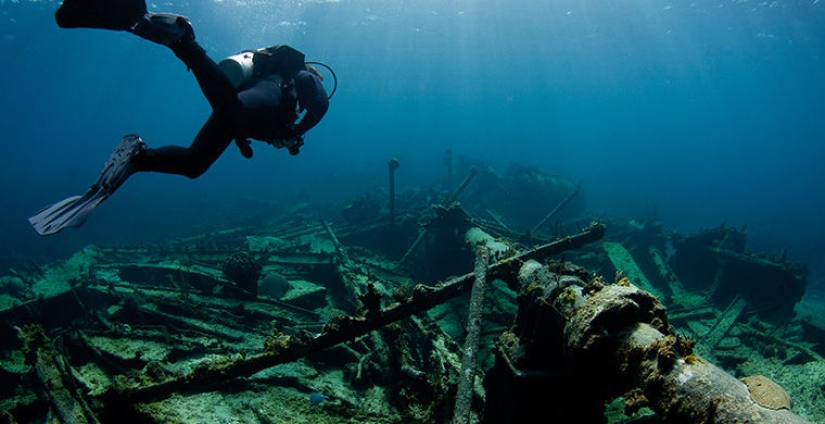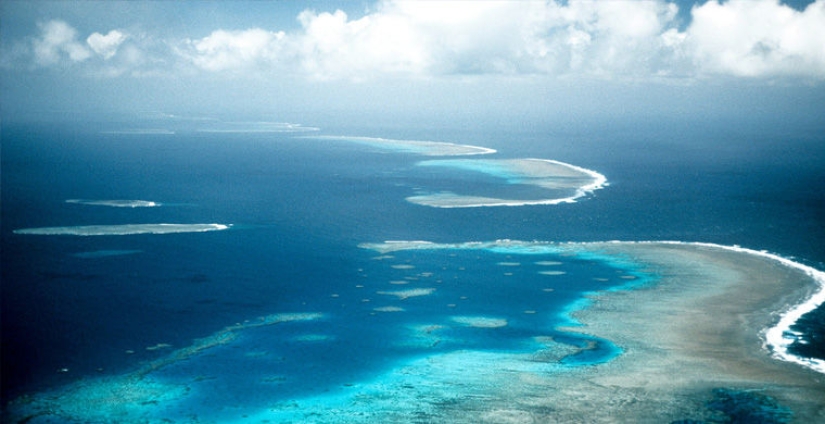The bottom of the ocean is literally strewn with wrecks. According to the UN, there are about 3 million This ancient galleys full of amphorae, and the court of first merchants and mariners, full of foreign goods, and pirate ships with the looted treasures, and Spanish Galleons carrying gold from the New to the Old world, and of the court of researchers and explorers, and many warships. They sank at different times under different circumstances.
We will talk about the biggest ships cemeteries that have the reputation of "the eaters of the courts": they seem designed to lure and destroy the boat with their passengers and cargo.


The most dangerous place for ships off the coast of the States is Cape Hatteras, North Carolina. Here comes the cold Labrador current and the warm Gulf stream. Storm winds, strong currents and changeable navigation difficulties led to a large number of shipwrecks and countless casualties in the vicinity of the Cape, in particular, on the banks of the diamond.

More than 1000 ships found here last shelter since 1526. Graveyard of the Atlantic, the area is dubbed the first Secretary of the Treasury Alexander Hamilton, he insisted on the construction of the Cape lighthouse, which was built in 1803 and still helps mariners to avoid the danger.

The most famous ship that sank here, the first battleship of the US Navy "Monitor", who died in 1862. The wreck is considered a national historic landmark.


Sable translated to English means "mourning", "gloomy". It is this characteristic is suitable for this small island in the shape of a Crescent. Around him, there were about 350 shipwrecks. Calculated as the lighthouse Keeper David Johnson, here perished in the average of three ships every two years. The observations were carried out since the 1800s, but the glory of the eater came to the Sable before.

As well as Cape Hatteras, canadian island known as the graveyard of the Atlantic, but it has a significant difference: he is able to literally devour ships, enveloping them in quicksand. The stranded ship Sable "swallows" all for two or three months, even if it is a huge ship with a displacement of 5,000 tons and with a length of up to 120 m. After some time the island has again "to spit out" ship on the surface — this is the paradox of the area.

Pernicious nature of the Sable is quite understandable. Near its shores are a number of warm and cold currents, and he was constantly hidden behind a dense fog and are able to change color due to the sandy shores of rocks, adapting to the water color of the ocean. In addition, it constantly changes the location: over the past 200 years Sable moved almost 10 nautical miles, each year he shifted to 230 m. These properties allow him to "cheat" the hundreds of captains and sailors.

The most tragic shipwreck off the coast of Sable occurred in 1898: in the mist of the French passenger liner "La Bourgogne" collided with the barque "Cromartyshire" and soon sank, taking the lives of 561 persons, including the captain, who did not want to leave the ship. Of the 200 women and 80 children were saved only one Victoria Lacasse.
Of the Austrian sailors and joined them men, panic, shooting at the other passengers, with the battle took boat, and beat people with oars and cut the fingers of those who tried to get out of the water. Later the Austrians were executed, and the collapse of the named Bartholomew in the morning.



In the English channel near the English town of Dover is the infamous Mel Goodwin, which killed more than 2,000 ships. According to one version, the shoal was formed by erosion of the island of Lomea. Under the influence of tidal Sands to change its shape and location, so the meeting with the always unexpected for stranded sailors. Often in the sand trap came sailing ships, which were brought here in a storm and fog, surf gradually washed from the sand, breaking in half.

If the ship is overturned and filled with water, people were often killed immediately. It is estimated that in the area of shoals Goodwin went missing 50 000 people. Some of the locals for centuries fed by shipwreck: they did rescue the stranded ships for remuneration or simply looting.

The English fleet lost here the best of their ships. One of them is a 70-gun ship of the line Stirling Castle, crashed in 1703, in 1979, local divers discovered at a depth of 12 m. Raised artifacts are kept in the Maritime Museum in Ramsgate's. The ship since it entered the sand, again thrown to the surface, his remains are protected by Britain and a wreck is a national monument.

In the Baltic sea, according to archaeologists, from 1128 until 1947, 26 703 sank the ship. More than 10,000 of them are from the Russian coast, of which about 2500 are buried in the Gulf of Finland. Researchers attribute a quarter of deaths in the Baltic ships to the Russian Navy, 19% German, 17% English, 8% are Dutch, 7% of Finnish. Most of the fragments recorded in the Bay of Vyborg: basically it is the court, killed during a major battle between the fleets of Russia and Sweden in July 1790.

Ships in the Baltic sea were drowned, for various reasons, and not only in warfare, but also because of the storms, collisions and landings stranded. Russian scientists have studied the seabed and built the Atlas of shipwrecks of the Baltic sea, but to raise to the surface of the court is not in a hurry, considering that the Baltic sea is in itself the best guardian of the underwater heritage. Due to the low temperatures, lack of living creatures, oxygen and light wooden wreckage perfectly preserved in deep mud.

One of the most interesting secrets of the Baltic sea can be attributed to the Dutch vessel "Frau Maria", crashed in 1771 at the åland Islands. His goods were works of art, acquired by Catherine II for the Hermitage and Pushkin. The ship was found by Finnish diver in 1999 at a depth of 41 m, but is still on the bottom.

In its hold, according to archaeologists, is a collection of Saxon porcelain, gold and silver statuettes, and about 300 of Flemish paintings, including works by Rembrandt. However, the operation to raise the estimated € 80 million, with stakeholders expressing doubts that the cargo had lain on the seabed for about 250 years, still represents the historic and cultural value.

Since Europeans learned about the distant land of America and has seen its wealth, began the era of the gold rush. All from 1503 to 1650 to Spain from the New world were exported 181 133 kg of gold and 16 886 815 kg of silver. Spanish Galleons, loaded South American treasure, followed through the Caribbean sea and the Atlantic towards Europe, but not all reached their native shores.

Inexperience sailors, poor navigation and inaccurate maps and treacherous West India hurricanes led to frequent shipwrecks. And themselves the ships were bulky and clumsy, besides they often helped to sink the pirates. According to experts, in the period between 1500 and 1820 in the sea were lost 850 ships, 340 of them were never found and investigated by Spanish rescuers.

According to others, only for the period from 1619 to 1659 673 sank the ship. Many are still buried in the vicinity of the greater Antilles is considered to be the Caribbean in this cemetery are buried not less than 400 sailboats.

One of the most famous ships lost here can be called the Spanish Galleon "the virgin", sunk in 1641 off the coast of Haiti. The huge ship had to smuggle all colonial silver mined during the year, but in the last voyage he was prevented by a storm and the error of the pilot. The treasure hunt began immediately, and in 1687, sir William Phipps was able to raise from the bottom 30 tons of silver. However, the sailor took to the grave the secret of the location of the wreckage, and the next time the ship started talking about three centuries later.


In 1977, the fragments of the vessel managed to find us the treasure hunters Burt Webber, raised from the seabed 32 tons of silver bullion and coins, gold jewelry and antique crockery $14 million According to experts, more than half of cargo "the blessed virgin" is still not detected.

According to the Department of environment and heritage of Australia, off the coast of Queensland lie hundreds of historic ships victims of shipwrecks.

The first Australian colonists and explorers often suffered shipwreck, trying to use the water between the reef and the mainland a Large lagoon for the passage to the ports of India and China, as well as the shortest route from the Pacific to the Indian.

The most famous ship that sank in the Great barrier reef, a 24 — gun ship of the Royal Navy "Pandora". He was sent to search the rebellious team "bounty", which managed to find and arrest of 14 people. In August 1791, Pandora sat on the outer edge of the reef and in the morning sank with 31 crew and four prisoners.

The wreck was discovered in 1977, a documentary filmmaker and Explorer Ben Kropp. Excavations still going on, raised the artifacts exhibited in the Museum of Queensland.

By the way, this year Kropp found in the Grand reef L brig Inconstant on which Napoleon escaped from Elba in 1815. Subsequently, the ship went to the British, and was renamed in 1831 sank.
Keywords: Ships | Travel | Ocean | Ship | Peace | Cemetery | Shipwreck
Post News ArticleRecent articles

Reddit users gathered once and let's brag about who and what they treat in school canteens. Both the students themselves and their ...

What kind of wedding traditions do not happen! The Scots pour dirty slush over the bride, some peoples of India have decided to get ...
Related articles

The Himalayas. Tibet. Something cosmic and ethereal sounds in the names. They attract visitors from all over the world. In front of ...

If you like peace and privacy, it is unlikely that you will choose a metropolis, going on vacation. Especially when in the world ...

Walking through this picturesque bridges, you can admire the views from these stunning views and breathtaking landscapes. We invite ...

The winter sky sometimes presents phenomena that seem almost unreal. Pearlescent, or nacreous, clouds are rare guests in our ...